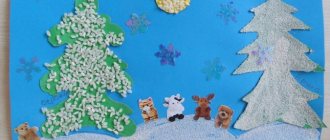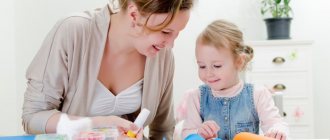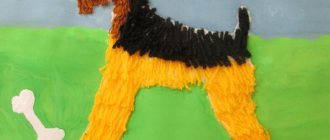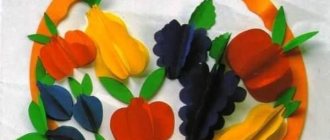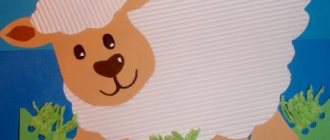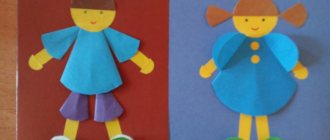Visual activities and especially appliqué in kindergarten are the most important factor in nurturing a creative personality.
Creativity in the visual arts of a preschooler is the ability to find ideas in complex, unusual situations, to see and use real objects in an unconventional way; the ability to change the shape of an object so that it acts in a new capacity; the ability to originally use and combine various means of artistic expression with elements of integration of types of visual activity, the result of which is one’s own work of art.
Children's visual arts, including appliqué in kindergarten, provide an opportunity to reveal typical and individual personality traits. Each child has his own mentality, his own logic; his thoughts are fresh, whole, and there is a lot of undisclosed content hidden in his soul, which is looking for better expression. Each person is individual in his own way, uniquely perceives the objective world and reproduces it on a plane with the help of certain artistic techniques, materials and techniques.
Today we will talk a little about applique as a type of visual activity.
Application - what is it?
Applique is a type of decorative and applied art, the principle of which is the technique of cutting, applying and attaching parts to a base. The name comes from the word applicatio, which in Latin means “application”.
Composing images using the appliqué method is the oldest technique for decorating household items among different nationalities, which is still used today. By gluing or sewing figures cut out from various materials onto a selected background, you can get not just a picture, panel or postcard, but also a real masterpiece.
Classification of application techniques
Since this type of image is distinguished by its silhouette, color distribution and expressiveness, pictures can be created using different techniques. Application techniques define:
color spectrum:
- monochrome,
- black and white,
- multicolor;
form:
- flat - elements cut from flat material are attached to the base;
- volumetric (convex) – elements of the surface layer have a volumetric shape, for example, lumps of cotton wool;
subject:
- subject – individual objects are depicted;
- plot - semantic display of action, plot, event;
- decorative – pattern, ornament, as decoration elements.
What are the benefits of the application?
Modern appliqué techniques for children combine the use of different types of textures. You can create a craft from plain, colored paper, bright fabric and waste material. For example, seeds, various types of cereals, and dried plant parts can be used in the work.
Today, many templates have been developed that allow you to create thematic compositions. They allow you to stimulate the attention, memory and imagination of a preschooler.
Professional teachers should prepare unusual topics for creative activities that arouse children's interest.
This type of creative activity is used to develop a teenager’s capabilities. Thanks to this, it is possible to develop your horizons and identify your main talents.
Application
Application (from Latin applicatio
- application) is one of the types of visual techniques based on cutting and superimposing various shapes and fixing them on another material taken as the background. The applique can be made of paper, fabric, or various natural materials.
Flower applications are called “floristry”.
To create your compositions, you can use dried leaves, fruits and flowers, straw, poplar fluff, shells, cones, seeds, seeds, herbs, etc. Each material has its own characteristics that must be taken into account.
There are three types of application:
• decorative, combining various elements of decoration;
• subject, consisting of individual images (bird, tree, fungus, house, etc.);
• plot, depicting some action or event (winter landscape, butterfly on the lawn, basket with flowers).
Decorative applique
This is the simplest and most accessible technique, even kids can handle it. The surface of each material is original and unique: soft leaves, rough cones, smooth stones, fluffy feathers and poplar fluff. By making decorations and patterns from different materials, the child learns to combine different shapes and colors, decoratively transform forms according to the laws of rhythm and symmetry.
Decorative applique is characterized by ribbon and central-radial compositions
.
In a ribbon composition, individual elements are repeated horizontally or vertically. In a central-ray composition, the pattern is drawn from the center to the edges, corners or sides of the selected background (it can be a circle, rectangle, rhombus, square, triangle).
Subject application
For subject
For appliques, it is best to select material that is represented in a large form. It is good to use leaves from different plants. For example, these can be large leaves of oak, maple, elm, aspen, chestnut. The shape of these leaves has a distinct configuration that needs to be played out.
Sequence of work: a large leaf is selected and fixed on the main background, and then smaller leaves are placed that convey the characteristic features of the depicted object. For example, the shape of an oak leaf resembles a bizarre figure of a man. Just add a small elm leaf and the little man will have a head. If you place a large elm leaf horizontally, the body of a fish will come out, and its fins can be made from small poplar leaves.
Subject application
Some rules must be followed here.
You should choose natural materials that will match each other in color and texture. Possible combinations: leaves and herbs, shells and pebbles, light large seeds and cone scales. Pay attention to the combination of the color of the materials and the main background. Color is very important, as it helps convey the mood of the picture, the time of year, and the character of the characters in the work.
It is necessary to focus on the main characters of the plot. The main characters stand out from the overall picture by their larger size, bright color, and compositional design.
The composition is usually built taking into account perspective. The parts are not arranged “in a row”. Anything closer will look bigger, and anything further away will look smaller. These are the classic rules of drawing and painting, so to create this type of appliqué you need to be at least a little bit of an artist. The selection and appropriate use of the color of materials and its combination with the main background are very important.
Backgrounds for applications
For the background of the applications, it is recommended to use white thick paper, colored, gray, beige cardboard, velvet paper, sisoflora, lace, birch bark, corn leaves or anything else that you can come up with.
The choice of background is determined by the natural material on which it will “sound” especially brightly. White paper, for example, emphasizes plants' outline, color and shape. Colored, gray and beige cardboard can serve as a background for laurel leaves, silver poplar, and corn, which become a continuation of the color base. Velvet paper has a soft surface on which poplar fluff and feathers can easily be attached. The classic combination is black velvet and straw appliqués.
Sizoflor (pictured left) is pressed fibers of different shades. It can be purchased at flower shops. This material looks especially good if it is fixed with glue on a white or colored background, an amazing effect is obtained.
Lace and white tulle also make a wonderful backdrop. It is recommended to use white wide lace. Tulle can be with different specified patterns, small or large; the main thing is that it is harmoniously combined with natural material. You can secure tulle and lace with glue on a colored or white background.
Birch bark (or birch bark) is an excellent background for plot appliqué compositions. For the base, use plywood or thick cardboard, onto which birch bark is glued. To prepare the background, it takes time, about a day, so that the birch bark is completely fixed.
Even dried corn leaves are used as a background. They can be fixed with glue on cardboard as an independent background. At the same time, corn leaves go well with birch bark.
Photos of works - from the book:
Natalia Vadimovna Dubrovskaya. A big book of applications made from natural materials.
Methodology for using templates
By working step by step with templates for paper crafts, children aged 6-8 years can accurately reproduce an exemplary composition.
With another approach, the child himself makes a choice among a large number of modules, cut out in the form of stripes, circles and other elements, creating unique color combinations.
Saving time is another factor that speaks in favor of using drawing or carved templates.
Elements that are difficult to perform independently (silhouette and perforated parts, drawings with polygons or strict requirements for sizes and proportions) allow you to create beautiful aesthetic works, which creates additional motivation for doing manual labor.
Applications for 2nd grade
As the baby grows, his needs in terms of understanding the world around him grow. Teachers need to make appliqué classes more complex; they should be more creative and beautiful. Practical skills and developing experience are important for 2nd grade students. In the 2nd grade, children are already accustomed to school, they begin to understand that it is important to develop their abilities independently, try to read and memorize more, and write down important points in notes.
Applications for 1st grade
For the youngest children in school, so that they quickly adapt to a different mode of work, it is necessary to think through the lessons in a fun and interesting way; this is where technology lessons come to the rescue, where you can make a variety of crafts. For work it is best to use:
- colored paper;
- multi-colored cardboard;
- pencils of different colors;
- scissors;
- glue.
If you offer them an interesting topic, they will work hard for a long time to create their work of art.
The most important thing in working with first-graders is to be able to organize them for creativity while completely capturing their attention.
A primary school teacher can make connections between subjects, i.e. In the lesson on the world around them, they get acquainted with the topic “Animals of our region”; you can continue to consolidate the material already at work by inviting them to make an application on this topic.
You can diversify the work as follows, distributing animals among students and initially inviting them to make a craft about the character they got.
For the next lesson, they can be asked to prepare an interesting story about an animal, thus preparing a presentation of their work.
Seven-year-old children will perceive this type of creativity well, since they really like to play games and read fairy tales, so they can also be asked to make an application to a work or fairy tale they have studied.
How is the application useful for a child?
Children in early childhood (from about 1 year old) begin to be interested in this type of activity. This is precisely one of the opportunities to develop a child’s fantasy and imagination, study colors and their combinations, as well as the shapes of objects, and develop fine motor skills. Applique classes encourage the development of a child’s thinking processes; he creates a whole from several parts and learns to divide the whole into elements. And, of course, such creativity contributes to the development of speech and spending time together.
By doing appliqué, a child masters the skills of working with paper, scissors and glue, becomes familiar with the properties of paper, learns to work with simple drawings and diagrams, reads symbols and creates a complete image.
Palms
It’s easier for kids to work using ready-made stencils. At the same time, even accurately tracing a cardboard template causes difficulties for many. To make work easier, children are given three-dimensional shapes - cubes, cups. Your own palms will also do, especially since you can make a lot of original crafts from the latter.
Principle of operation:
- On paper, the child traces his own palm, trying to carefully outline all the fingers.
- Independently or with the help of a teacher, the child cuts out the paper according to the shape.
- A craft is glued together from ready-made parts, the diagram of which was suggested by the teacher. Options can be given to choose from.
To glue the palms, you can use a glue stick or plasticine. The proposal to create one Christmas tree or a snowman from the palms of the whole class will also be an educational moment - a clear demonstration of what children can do together.
Herringbone
The simplest Christmas tree, which even children of the younger group can handle, is a pyramid glued together from triangles. After fixing the main shape on a cardboard base, you can invite children to decorate the Christmas tree with buttons or confetti that will imitate balls. Older children can cope with more complex options - an embossed and voluminous Christmas tree.
To make a Christmas tree from cut ribbons, you need to prepare 5-6 strips of paper. In this case, long ribbons will be required for the lower tier, and short ones for the upper tier. You can cut the workpieces to length in advance or during assembly. The basis of the craft is a cone glued together from cardboard or thick paper. The Christmas tree can be made traditional green and then decorated, or creative.
Simple small Christmas trees can be assembled into a garland or placed in a frame. In the first case, the paper must be double-sided. You can corrugate a cut out isosceles triangle manually, pressing the folds with a ruler or pencil. Children from 5 years old can handle making such an accordion.
Other ideas for creating a Christmas tree out of paper:
Applications for 4th grade
4th grade schoolchildren are already endowed with the ability to easily work with scissors, draw and glue. Applique classes should have the goal of a more creative approach to work, of creating unique creative works. Children at this age can start working with templates and cut out identical shapes in a faster way.
In addition to school appliqué lessons, children can invent and experiment at home with their parents. Parents, no worse than teachers, can show their children examples of their work and suggest their methods of creative ideas.
Application is exactly the type of useful activity that can unite adults and children in their work. At any age of their student, it is important for parents not to stop the child’s development, but to give him more and more difficult tasks.
Children need the care and affection of their mothers and fathers; creativity is a great way to spend quality time with your child. If applications become a regular activity for you and your child, then you can use non-standard approaches in children's masterpieces. For example, an image of a Christmas tree can be created by gluing 3 green triangles on top of each other.
Snowman - white proportional circles are located one above the other. Children love such associations.
The main thing is that children’s thinking needs to be properly directed, then in the future it will be easier for them to navigate the modern world. Three-dimensional thinking, developed since childhood, helps architects, designers, constructors, artists, etc. Applique lessons force children to adapt and get used to modern living conditions - if you litter in class, be sure to clean up your workplace after yourself, this is how the habit of cleaning everything up after your work is formed.
In appliqué crafts, children express themselves and create their own aesthetic taste. Anyone can do appliqué, and they don’t have to be artists and designers.
Fairy lights
Children can be involved in making a New Year's garland to decorate the classroom or school Christmas tree. What is difficult to do alone, children will do together. The main thing is that the sizes and general appearance of the segments that schoolchildren make are the same. This is the only way a set of crafts will look like a single whole. Colors and design details may vary. You can divide children into groups, each offering its own type of segment.
There are many options:
- Simple balls made from stapled circles or paper strips.
- Chains assembled from strips.
- Ornaments cut from a single sheet folded into an accordion.
- Stars, Christmas trees, snowflakes strung on threads, symbols of the coming year.
- Boxes folded using origami technique.
- Segments made of paper strips are ornaments using the quilling technique.
In kindergarten and elementary grades, it is important that the work be signed, even if the child has made at least one snowflake. From middle school, work can become a collective endeavor.
A little about the types of applications
By topic, the following types of applications can be distinguished:
- Subject - a simple type of application for children. An element is cut out of the material and glued to the base.
- Subject - the image no longer consists of one, but several links that make up an event or action in the background.
- Decorative - forms a repeating pattern that is used to decorate albums, frames and household items.
Paper is the main material for applique. However, in addition to it, you can use other materials, whatever your imagination allows: fabric, leather, multi-colored beads, seed beads, woolen threads, leaves, seeds, cereals and much more.
By color, the applique can be colored, black and white or single color.
Depending on the volume, flat and volumetric applications are distinguished.
Overhead, cut-off, silhouette, modular, ribbon... and this is not all types of applique!
And to understand how diverse this art technique is, it is enough to get acquainted with the most popular and interesting types of children's applications, examples of which are given below.
Star
A luxurious eight-pointed Christmas star can be made even without blanks and patterns. You will need squares of thick paper, a ruler, a pencil and scissors. You will only have to mark the diagonals and transverse folds; for density, you can press them with the tips of scissors so that the folds are expressive. Having made four cuts, we fold the rays.
After gluing, you need to squeeze the corners so that the star acquires volume. After this, we glue the two blanks at an angle so that the craft takes on its final form.
Rainbow in the clouds
You will need: colored cardboard, scissors, glue stick, cotton wool, stapler.
Master Class
- Cut 7 strips of paper of different colors so that each piece is shorter than the previous one. The red stripe should be the largest and the purple stripe the smallest.
- Arrange the stripes in the following order: red, orange, yellow, green, blue, indigo and violet.
- Fasten the strips of paper together using a stapler.
- Roll 6 cotton balls.
- Glue 3 cotton balls at the base of the rainbow as clouds.
Rainbow in the clouds is ready!
Volumetric applique “Cacti”
You will need: double-sided colored paper in green and red, a sheet of cardboard, scissors, glue.
Master Class
- Cut out the templates.
- Prepare 5 templates for each cactus. There are 25 ovals in total.
- Fold each template in half.
- Cut sharp spines from red paper.
- Glue the spines to the green blanks.
- Assemble one cactus from 5 blanks, as shown in the photo.
- Make 5 cacti in the same way and glue them onto a piece of cardboard.
- Cut out 4 flowers from red paper and glue them to the tops of the cacti to make them bloom.
The volumetric applique “Cacti” is ready!
Stencils for appliques - a selection for printing
Stencils for appliques - selection for printing:
Stencils for appliques Stencils for appliques Stencils for appliques Stencils for appliques Stencils for appliques Stencils for appliques Stencils for appliques
Stencils for applications Stencils for applications
Crafts “Christmas trees”
We offer you 4 options for how to make a craft with a Christmas tree. We will make cards, applications and a New Year's toy.
New Year's card "Delicate Christmas tree"
Let's make a postcard - a transformer. When closed, the Christmas tree looks like an ordinary one, but as soon as you open the postcard, the holiday begins!
Craft “Christmas tree” from a sleeve
Crafts made from bushings are a special love! Such affordable material and so many interesting things you can make from them, for example, a Christmas tree. To do this, we will fold the sleeve in half and make cuts. The final work can be used as a Christmas tree decoration. This craft can be done by children aged 3 years and older.
You can think about what a green beauty might look like in the “Living Christmas Tree” master class. Download the finished template. Children under 4 will need help cutting out as the lines are curved.
Or make an applique from paper circles. For children under 4 years old, make a lot of blanks from colored paper and show them how to fold them. Then they can handle it themselves! As an additional decoration, we use semolina, which is so similar to snow.
For older children (from 6 years old), we invite you to try out elements of the origami technique to create your own New Year’s cards. Three craft options for your choice!
Sources
- https://dnevnikmastera.ru/applikaciya-dlya-1-2-3-4-klassa
- https://urokirukodelie.ru/applikacziya-v-shkolu-1-2-3-4-klass/
- https://hobbi.guru/podelki-iz-bumagi-s-shablonami/
- https://podelochkin.ru/applikacziya-1-2-3-4-klass
- https://orechi.ru/podelki/novogodnie-podelki-iz-bumagi
- https://gamejulia.ru/origami-dlya-1-klassa.html
- https://svoimirukamy.com/podelki-iz-tsvetnoj-bumagi-dlya-mladshih-klassov.html
- https://svoimirukamy.com/applikatsii-iz-bumagi.html
- https://creativebaby.ru/50-zimnih-podelok-dlya-detey-s-shablonami/
[collapse]
